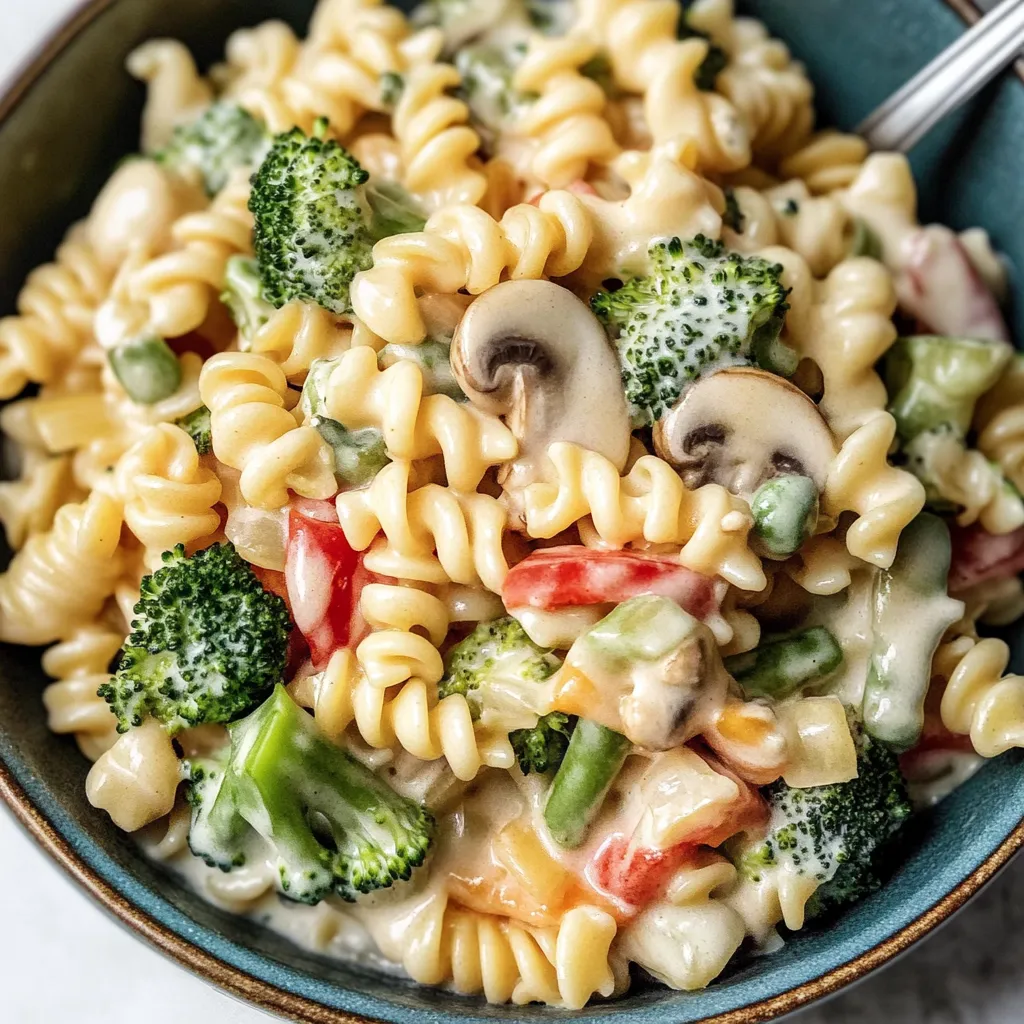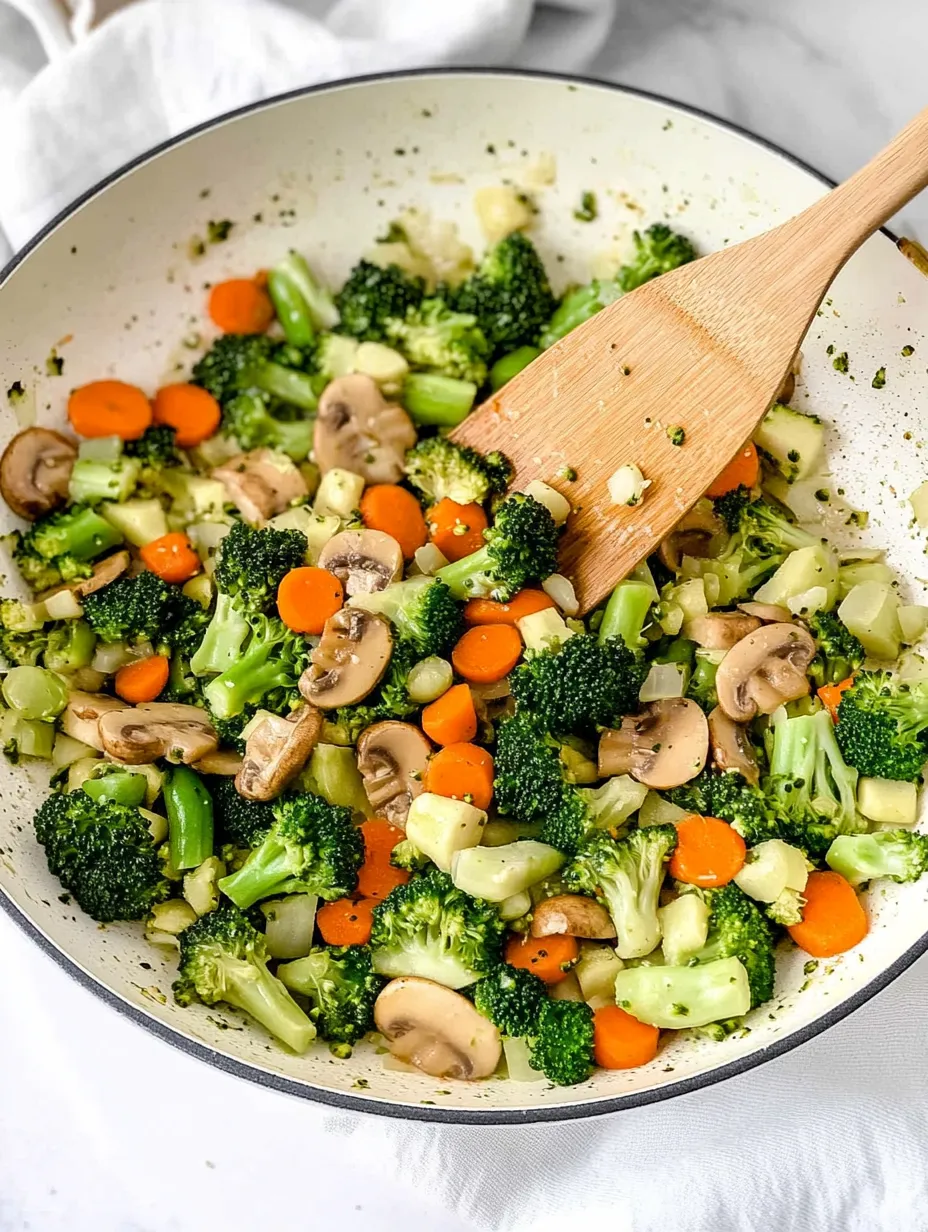 Pin it
Pin it
This creamy veggie pasta has been my weeknight dinner savior for years. Packed with colorful vegetables and surrounded by a luscious dairy-free sauce, it delivers restaurant-quality flavor in just 20 minutes of cooking time.
I first created this recipe during a busy week when I needed something my whole family would eat without complaints. It's now become our Monday night tradition, and my children actually ask for "the rainbow pasta" by name. The secret is in how the vegetables caramelize slightly before meeting the creamy sauce.
Ingredients
- Pasta: Any shape works perfectly. I prefer rotini or penne for how the sauce clings to all the ridges. Choose gluten-free pasta if needed without affecting the final result.
- Light olive oil: Creates the foundation for sautéing without overwhelming the vegetables with heavy flavor. Use any neutral oil you have on hand.
- Garlic: Minced fresh cloves provide aromatic depth. Adjust according to your love of garlic, I sometimes double this amount for extra punch.
- Zucchini: Adds pleasant texture and mild flavor that soaks up the sauce beautifully. Choose firm, medium-sized zucchini for best results.
- Broccoli: Provides excellent texture and nutrition. Cut into small florets to ensure they cook evenly within the short cooking time.
- Mushrooms: Bring earthy umami flavor that makes this dish incredibly satisfying. White or cremini varieties work wonderfully.
- Bell peppers: Sweet and colorful addition that brightens both flavor and appearance. Mix red, yellow and orange for the most vibrant presentation.
- Cherry tomatoes: Burst during cooking to release sweet acidity that balances the creamy elements. Look for ripe but firm tomatoes.
- Baby spinach: Wilts perfectly into the sauce adding nutrition and color. Fresh spinach works best here.
- Vegan sour cream: The secret to incredible creaminess without dairy. Store-bought works perfectly, or use homemade for extra richness.
- Nutritional yeast: Optional but adds wonderful cheesy flavor without any dairy. Even a tablespoon makes a noticeable difference.
- Pasta water: The magical ingredient that helps create a silky sauce that clings to pasta. Always reserve some before draining.
Step-by-Step Instructions
- Boil the Pasta:
- Fill a large pot with water, add a generous pinch of salt, and bring to a rolling boil. Add your pasta of choice and cook according to package directions until al dente. Before draining, remember to reserve at least 1 cup of that starchy pasta water.
- Prepare the Aromatic Base:
- In a large frying pan or wok, add your olive oil and minced garlic. Keep the heat at the absolute lowest setting while you prepare your vegetables. This allows the garlic to infuse the oil without burning, which would create bitterness.
- Prep and Add Vegetables:
- While the garlic is slowly warming, wash and chop all your vegetables into bite-sized pieces. Keep them relatively uniform in size so they cook evenly. Add the harder vegetables first zucchini, broccoli, mushrooms, and bell peppers into the pan. Season with salt and Italian herbs, which will help draw out moisture and develop flavor.
- Sauté the Vegetables:
- Increase heat to medium and cook for 6-8 minutes, stirring occasionally. Look for the vegetables to darken in color and begin to soften. They should maintain some texture rather than becoming mushy. The mushrooms will release moisture then begin to brown slightly, which indicates developing flavors.
- Add Quick-Cooking Vegetables:
- Now add the cherry tomatoes and baby spinach. These delicate ingredients need just 1-2 minutes of cooking. The tomatoes will begin to burst and release their juices, while the spinach will quickly wilt into the mixture, creating pockets of vibrant green throughout the dish.
- Create the Cream Sauce:
- Pour in half a cup of reserved pasta water, followed by the vegan sour cream and nutritional yeast if using. Stir continuously to create a smooth, cohesive sauce. Gradually add more pasta water until you reach a slightly thinner consistency than desired, as the sauce will thicken upon standing.
- Combine and Finish:
- Turn off heat once the sauce begins to gently bubble. Add your drained pasta directly to the sauce and toss thoroughly until every piece is coated. The pasta will absorb some of the sauce, creating the perfect creamy texture. Taste and adjust seasoning with salt, pepper, or red pepper flakes for heat if desired.
 Pin it
Pin it
My absolute favorite addition to this recipe is a squeeze of fresh lemon juice right at the end. I discovered this by accident when I had half a lemon leftover from making tea, and the bright acidity completely transformed the dish. Now my family notices immediately if I forget this final touch. The acid cuts through the creaminess and makes all the flavors pop.
Make Ahead and Storage
This dish stores beautifully in airtight containers in the refrigerator for up to 4 days. The flavors actually develop overnight, making it taste even better the next day. When reheating, add a small splash of water or plant milk and warm gently on the stovetop or microwave. The sauce will thicken considerably when cold but loosens back up with gentle heat. If planning to make ahead, consider cooking the pasta slightly less than al dente so it doesn't become too soft when reheated.
Clever Substitutions
No vegan sour cream? This recipe works wonderfully with homemade cashew cream, coconut cream, or even silken tofu blended until smooth. Each alternative brings a slightly different flavor profile but maintains the luxurious texture. For cashew cream, simply soak 1 cup of raw cashews for at least 2 hours, then blend with 3/4 cup water, 1 tablespoon lemon juice, and a pinch of salt until perfectly smooth.
Seasonal Variations
Summer version: Use abundant zucchini, yellow squash, fresh corn cut from the cob, and cherry tomatoes for a celebration of summer produce. Add fresh basil instead of Italian herbs.
Fall harvest: Replace summer vegetables with butternut squash cubes, brussels sprouts, and kale. Add a pinch of nutmeg to the cream sauce for warmth.
Spring celebration: Highlight asparagus, peas, and tender spring onions with a generous amount of fresh herbs like dill and chives stirred in at the end.
Winter comfort: Use hearty root vegetables like carrots, parsnips, and turnips, roasting them first for deeper flavor before adding to the creamy sauce.
Frequently Asked Questions
- → What type of pasta works best?
Any shape of pasta works well, such as penne, fusilli, or spaghetti. Choose gluten-free pasta if needed.
- → Can I use different vegetables?
Yes, you can substitute or add vegetables like carrots, asparagus, or cauliflower for a personalized touch.
- → How can I adjust the sauce thickness?
Use more or less pasta water or veggie broth to achieve your desired consistency. The sauce thickens as it cools.
- → Can I make this dish ahead of time?
It’s best served immediately while hot, but you can refrigerate leftovers and reheat gently with a splash of water to loosen the sauce.
- → Is it possible to make it nut-free?
Yes, use store-bought vegan sour cream that’s nut-free, or substitute with a coconut-based cream for similar results.
